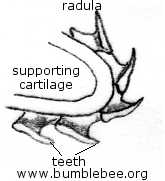
Adaptation
 Gastropoda have evolved to their various environments and
have made many adaptations that have allowed them to not only
survive, but to flourish into some of the most successful groups
of the animal kingdom (Hickman
et al., 2009).
Gastropoda have evolved to their various environments and
have made many adaptations that have allowed them to not only
survive, but to flourish into some of the most successful groups
of the animal kingdom (Hickman
et al., 2009).
The Radula:
The Majority of land snails are herbivores and feed on fungi or
plant life: such as bark or leaf litter (Dourson, 2010). In order to
feed these snails have developed a structure called a radula that
they use to feed (Gillis, 2012). The snails use this to scrape of
bits of food into their mouth to be ingested (Gillis, 2012)
Calcium Carbonate Shell:
Gastropods have a fleshy body that is food for the vast majority of
other organisms (Dourson, 2010). They
make their protective shell from
calcium carbonate and is excreted by the mantle of the snail (Dourson,
2010).
Torsion:
Most modern day snails have the anus located by the head, but this
wasn't always the case, before the evolution of torsion the mouth
and the anus were on opposite sides of the shell (Gillis, 2012).
This required two opening of the protective casing of the shell,
leaving the snail more vulnerable to predation (Gillis, 2012). The
180 degree twist, torsion", helps the snail survive because now it
only only has one opening to protect (Gillis, 2012).
Having the anus this close to the head could cause some problems
while feeding, so the snails simply do excrete their wastes when they eat (Gillis,
2012).
Hermaphroditic:
Snails are remarkably slow, with the fastest species moving
at a max rate of about 55 yards/hour (BioExpedition).
It is quite possible that they may not find another mate during
their lifetime and this fact was what makes their hermaphroditic
nature so important (Hickman
et al.,
2009). If a snail doesn't meet a mate, they can self fertilize,
keeping their lineage going until they meet a mate, where they act
as both female and male to make the most out of each encounter. (Hickman
et al.,
2009).
Oxygen Breathing Lung:
The Patera laevior, and all other land snails, have
converted their mantle into a vascular, air breathing lung (Hickman
et al.,
2009). The opening that allows them to breathe air is located on
the side of the mantle and is called a pneomostome (Gillis,
2012).
 Direct
Life-style:
Direct
Life-style:
When the snails first moved to land, they made another very
important adaptation, the direct life-style (Hickman
et al., 2009). This means that the snails lost their trocophore
larval stage and give birth to infant adult staged snails (Hickman
et al., 2009). The figure to the right shows that trocophore
stage that was given up, courtesy of ZipcodeZoo.